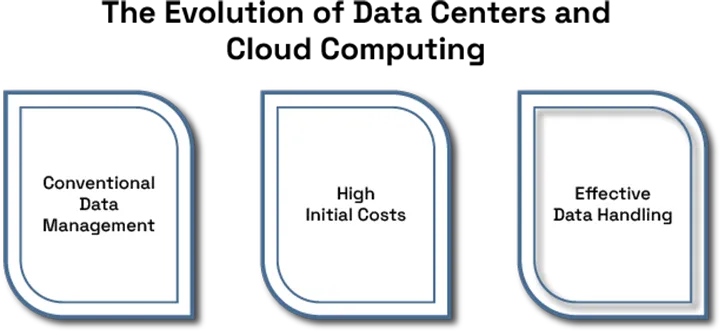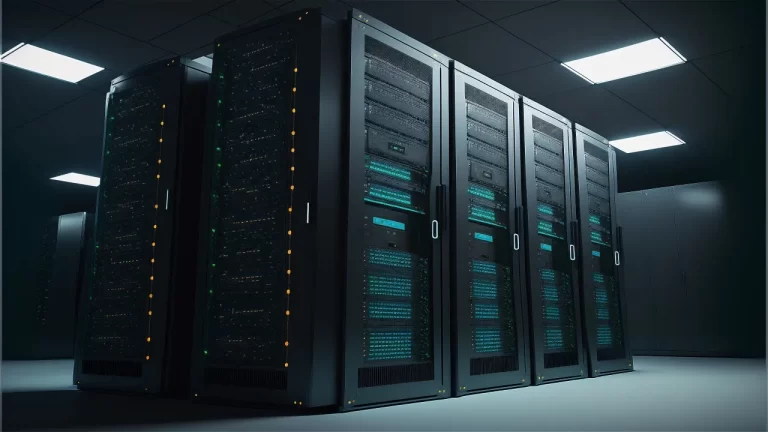Cloud computing has quickly transformed the way businesses approach data center infrastructure. By allowing scalable and flexible service, it allows organizations to grow their IT capabilities without heavy capital investment in physical infrastructure.
The Evolution of Data Centers and Cloud Computing
Traditionally, enterprises have established their own data center to address the requirements and demands of computing and data storage. However, with increased demand for data processing and data storage ability, data centers implemented a rather conventional style. Cloud computing which changed the way terms companies manage data.
Cloud computing refers to the outsourcing of data storage facilities, computation services, and networking services from cloud providers. This has done away with the high initial costs of investment, and that means companies can easily expand or contract depending on the demand. Because of the effectiveness of the cloud-based data centers in this realm, organizations that deal in hyper-scale computing can leverage the centers’ effectiveness in handling such large data and flexibility immensely.

Scalability in Cloud Computing Data Centers
Scalability is one of the primary realities that make cloud computing centers advantageous to implement. In traditional data centers, there has been limited physical space, power, and cooling in data centres which has proved to restrict service providers from delivering maximum value to their customers. However, in Cloud computing infrastructure, the process of scaling is more dynamic. This makes it possible for companies to have a policy of usage of the data center by adjusting the power of the data center according to the needs of a certain period.
For example, public cloud data centers add or remove scalability features such as storage and processing capabilities on the fly. This scalability is especially useful in cases where the demand changes frequently in an e-commerce site or a financial organization. It means that it is another cost saving measure as most of the cloud service providers work on the pay-per-use models.
Flexibility in Cloud Computing Data Centers
Other advantages of either cloud computing data center include the ability to scale up and scale down providing as per the needs of customers. Traditional data centers are static in nature and any change to them is an important event, which demands a lot of time and capital. However, with data centers based in the cloud, it is easy to adapt to the dynamics of business.
For example, in virtual machines in cloud computing solutions, it is possible to quickly allocate and deallocate IT resources. This flexibility implies that companies can implement new applications or technologies without being limited to physical hardware. While making a new modification from testing an innovative feature, executing a disaster recovery plan, or moving to a new software environment, perhaps the biggest advantage of the cloud is that one can easily implement a wide range of changes rapidly.

Hyperscale Cloud Computing Data Centers: The Frontier of Flexibility and Scalability
The globe leaders in cloud computing are the hyperscalers of cloud computing data centers. These giants are built meet the future needs of the largest companies and organizations, implementating petabytes of information and supporting millions of people all around the globe. These large service providers like Amazon Web Services (AWS), Microsoft Azure, and Google Cloud operate many facilities for on-demand public cloud data centers.
That means the ability to deliver high performance, high reliability, and high efficiency at a large scale is only possible with these hyperscale cloud computing data centers. It gives the organizations the capacity to manage huge operational loads, intensive computing, and data storage. These also use advancements in technologies as automation and artificial intelligence, and machine learning, in handling their processes to achieve functionality to support the growing needs of the organizations without much intervention from humans.
Sustainability and Trends in Data Center Operations
As the market for cloud computing improves, the data center sustainability trends also increase. Cloud computing data centers can provide a greater amount of green solutions than traditional data centers because they can reduce energy usage. Many cloud providers have adopted the renewable energy ring to achieve 100% of the energy used by their data centers.
Different trends affect data centers, including the use of liquid cooling systems energy-efficient hardware, and improved power management systems. It also contributes to the environmental problem through the introduction of virtual data centers in cloud computing. Integrated cloud data centers available to businesses make it easier to reduce carbon use and minimize the use of local hardware components that are associated with data centers, which helps in achieving data center sustainability goals.
Further, the future data center trend is edge computing, where data is processed closer to its source and the required bandwidth. There are many advantages of employing the edge data centers especially in IOT, autonomous systems and real-time processing purposes.
Impact of Cloud Computing on Data Center Flexibility and Network Efficiency
The data center cloud network is a component that opens up the cloud computer’s flexibility and scalability that cloud computing promises. This makes it possible for businesses that accept the cloud to improve their network flow with an aim of improving the transfer of data across different areas. This has become a standard in the world economy that requires organizations to achieve high-quality results in their performance across geographical locations.
Transmission of data within the cloud computing technology is a well-developed networking technology to make sure that data between the cloud service provider data center and the users is transmitted effectively. These networks are intended for large flow of data, and give low delays and high reliability which are beneficial for real-time application.
Conclusion
In conclusion, it can be decided that cloud computing had a positive impact on the scalability and flexibility of the data center. Hyperscale cloud computing data centers and virtual data centers are recent and highly key players in computer facilities that have changed the strategies of managing the IT infrastructures of companies entirely. As long as cloud providers enhance efficiency, sustainability, and capacity, then data centers and cloud computing have a very promising future as they provide greater levels of agility, cost, and performance attributes for organizations around the world.








